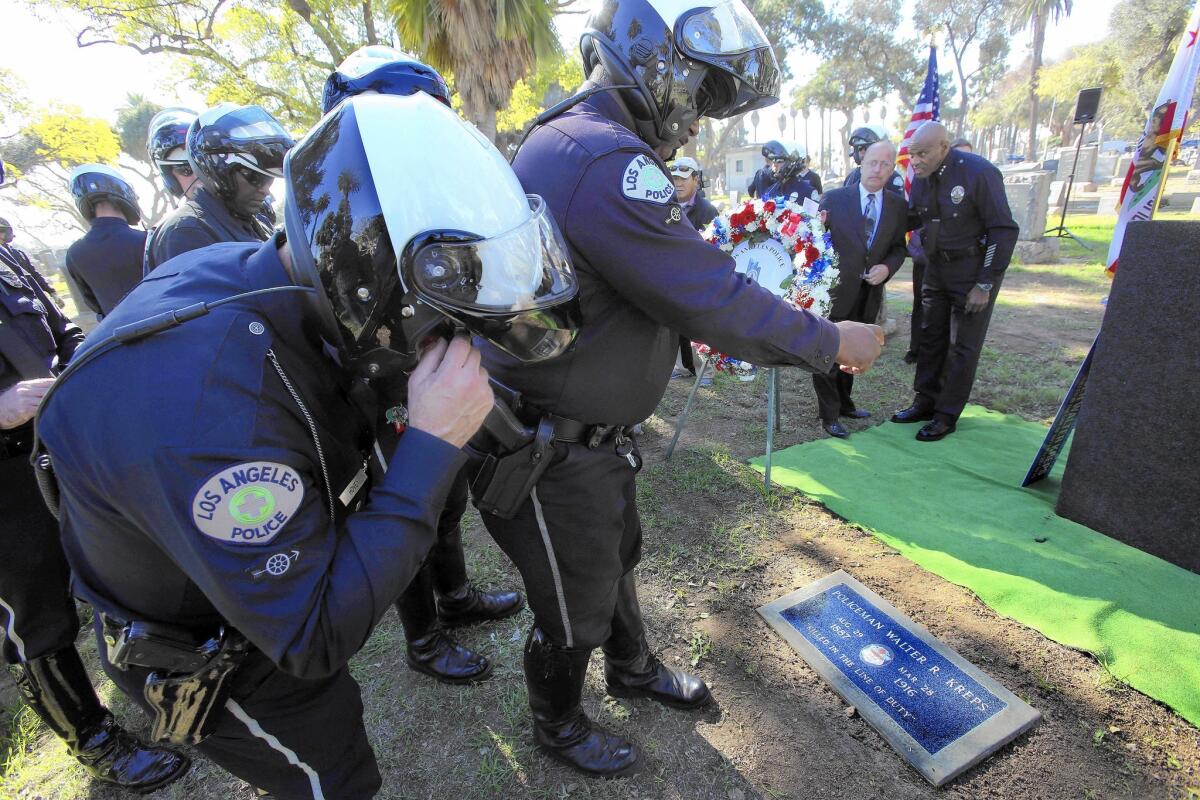Ninety-eight years later, LAPD takes time to remember one of its own

Walter R. Kreps, a Los Angeles police officer, was killed in the line of duty. He was on Avenue 20, racing to respond to a call, when a police car trying to pass a slower automobile collided with his motorcycle.
Kreps was 28, married with a 6-year-old son, when he died on March 28, 1916.
On Friday morning, 98 years, seven months and 25 days later, Los Angeles police officers gathered on a lonely stretch of grass to honor his service and to mark his unmarked grave.
That such a ceremony had come so late prompted apologies.
“Unfortunately, the circumstances of time and the passage of time have prevented us from acknowledging this hero in the way that we really should have,” Assistant Chief Earl Paysinger said at the gravesite.
That the acknowledgment had occurred at all, after so long, was remarkable.
It took place in a part of Angelus-Rosedale Cemetery in Pico-Union where most of the dead are very long dead and offerings of fresh flowers are few.
Next to the spot where Kreps was buried, the Los Angeles Police Memorial Foundation had placed a huge wreath in red, white and blue.
The foundation had flown a distant relative to L.A. from Missouri. An LAPD motorcade had whisked him from police headquarters to the cemetery.
There, more than 30 motorcycle officers in white helmets and crisp blue uniforms formed two lines, saluting and standing ramrod straight between graves.
White-gloved members of the LAPD Honor Guard presented the colors. Officer Rosalind Curry sang the national anthem. A police helicopter let out a brief siren wail as it flew low over the cemetery’s tall palm trees. On the ground, a cloth was pulled back to reveal a new granite grave marker — with a shiny image of Kreps’ badge at its center.
Records get misplaced. Memories fail. People once known to many are no longer known to anyone.
Kreps was the first LAPD motor officer killed in service, and the first LAPD officer killed in a traffic collision involving another police vehicle. His badge is framed on a wall outside the entrance to LAPD headquarters. His name is there, too, on a memorial wall for fallen officers, as well as on an annual award given to motorcycle squads.
But so much time has passed. Kreps’ immediate family is dead. No one had reason to check the status of his grave until Timothy Tumbrink got interested.
A couple of years ago, Tumbrink, of Vichy, Mo., began dabbling in genealogy because he believes that “in order to know who you are, you have to know where you came from.” His mother’s maiden name was Kreps. He stumbled upon Walter Kreps.
Kreps, he learned, had been a hose man for the Los Angeles Fire Department before he joined the police force in 1910, where he eventually rode an Indian motorcycle as a member of the quick-response speed squad.
Tumbrink identified with Kreps twice over.
He’s a retired officer with the St. Louis Metropolitan Police Department, and spent three years as a motorcycle officer. His twin brother, Thomas, was a firefighter in University City, Mo., when he was injured on duty at 23. He died three years later from those injuries, said Tumbrink, who plans one day to share his brother’s burial plot.
On a website called Findagrave.com, where people look up and contribute information about gravesites, Tumbrink documented his brother’s grave and found a listing for Kreps’. Another person on the site, who lives in Los Angeles, volunteered to go take a photo for him.
When Vickie DeMaria Gutierez found the grave unmarked, the two strangers, who became long-distance friends, began reaching out to the police department to change that. On Friday, at the cemetery, Tumbrink and Gutierez hugged each other.
Gutierez said her father took his own life when she was 10. “It’s very important to me to make sure people have a place of solace,” she said of her interest in gravesites.
A small tribute to Kreps now sits, until the end of the month, in the lobby of police headquarters. It features an Indian motorcycle and a couple of vintage photos, including one of the young officer, whose skull was fractured in the collision.
Motorcycle officers back then wore tweed riding hats and coats, and leather riding gloves. No one had heard of a motorcycle helmet.
In the cemetery, Tumbrink said that he’s still not sure exactly how he and Kreps are related, and that it would take a lot more research to find out. No matter. He feels a strong connection.
Though he doesn’t believe in clairvoyants, he said, many years ago he went to see one, the mother of a dispatcher he worked with, because he was mourning his brother.
“I sat down and she started talking. She said, ‘There’s a man over your shoulder on a motorcycle.’ I said, ‘Really?’ She said, ‘Yeah, he’s wearing a police uniform and it’s an old, old, old vintage motorcycle.’ At the time, I couldn’t figure out who this would be. Tell me that doesn’t blow your socks off!” he said.
Follow City Beat @latimescitybeat on Twitter and at Los Angeles Times City Beat on Facebook.
More to Read
Sign up for Essential California
The most important California stories and recommendations in your inbox every morning.
You may occasionally receive promotional content from the Los Angeles Times.











